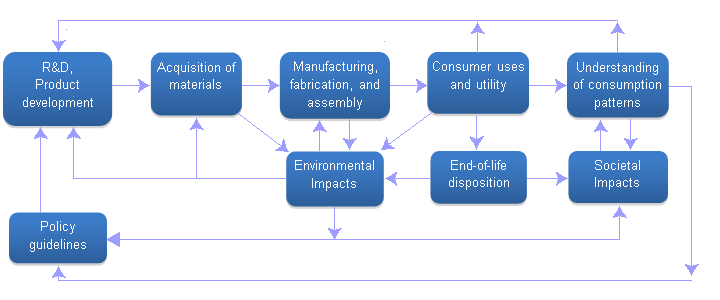| << Chapter < Page | Chapter >> Page > |
Figure LCA Framework Applied to Product Development , illustrates in a general way how the LCA framework can be structured for understanding how product development can benefit from the various material and information transfers and feedback loops along the product chain. Such a figure illustrates the complexities involved in creating, marketing, and discerning the impacts of a product or service, and raises the general concept of what is often referred to as product stewardship , an approach in which products are conceived, designed, manufactured, and marketed within a systems thinking context. It is a way of framing environmental problems that recognizes the three parts of the sustainability paradigm, and incorporates the concepts of sustainable manufacturing, marketing, utility-to-society, impacts of the use of the product, and end-of-life disposition of the product.

The problem of lack of uniformity in measuring, assessing, and valuing business actions taken at least in part for the sake of sustainability might be dealt with more effectively through the development of uniform standards and metrics that are applied by an agreed upon authority who uses transparent methodologies and reporting techniques so that other companies, and consumers, can make more objective judgments about comparative performances. From what has been presented in this section this may appear to be a near-impossible task. Yet attempts in this direction are being made, for example by the aforementioned World Business Council for Sustainable Development, the Organization for Economic Cooperation and Development , and the United Nations Millennium Development Goals . One of the more popular approaches for measuring and ranking corporate sustainability has been developed by the Dow Jones Corporation (DJC), through its Sustainability Index (DJSI). It may seem ironic that such a bastion of the free market economy has put together a system for measuring and assessing corporate sustainability, yet the size and general acceptability of DJC by corporations and investors work in favor of the establishment of an objective and transparent index. The DJSI itself was created in 1999 in response to the need, articulated from many sectors including consumers, for a way to assess progress toward sustainable corporate responsibility. The index contains three general evaluative sectors – economic, social, and environmental – that reflect the Brundtland definition. Each sector is composed, in turn, of specific categories as follows:
Economic
Social
Environmental
Each of these categories is composed of quantitative measures and assigned a specific, and constant, weighting. From the data gathered, a “best-in-class” (i.e. industry class) ranking is published annually. The index has engendered considerable corporate competition such that mere attainment of the previous year’s statistics, for a given company, usually results in a drop in rank. Of course one can argue with the choice of categories, or the data that are gathered and the way categories are parameterized, or with the weighting scheme used, but the important aspects of DJSI (and other sustainability rankings) is its comprehensiveness, uniformity, and transparency.
In the final analysis, no economy can move in the direction of sustainability without the active participation of the business sector. In other words, significant progress cannot be achieved through government or individual actions alone. As noted above, this creates difficulties and conflicts for businesses. As they continue to work together in the future, businesses and sustainability experts face many questions such as: What are the best measures of sustainability and how should businesses develop and plan for delivering more sustainable products and services? Is reliance on eco-efficiency enough to reduce the impacts of increasing consumption? Should businesses play a more significant role in educating consumers on the factors that affect sustainable development? How can businesses adapt to uncertainties that lie beyond the near term? What is the role of government in overseeing or regulating business activities that contribute to sustainability?
Find a product chain for the manufacture of a major consumer item such as a flat screen television, a computer, or an automobile and cast the stages of the chain in life cycle form as shown in Figure LCA Framework Applied to Product Development . As part of your answer, define the various information transfers and feedback loops involved.
Consider the various types of costs in the total cost accounting framework. In proceeding from Type I to Type V, give reasons why uncertainties usually increase at each level?
What are the main attributes of a sound index for measuring progress toward sustainability of products and services?
The World Business Council for Sustainable Development
Greenpeace (2011). Greenwashing. Greenpeace . Retrieved December 17, 2011 from (External Link)

Notification Switch
Would you like to follow the 'Sustainability: a comprehensive foundation' conversation and receive update notifications?